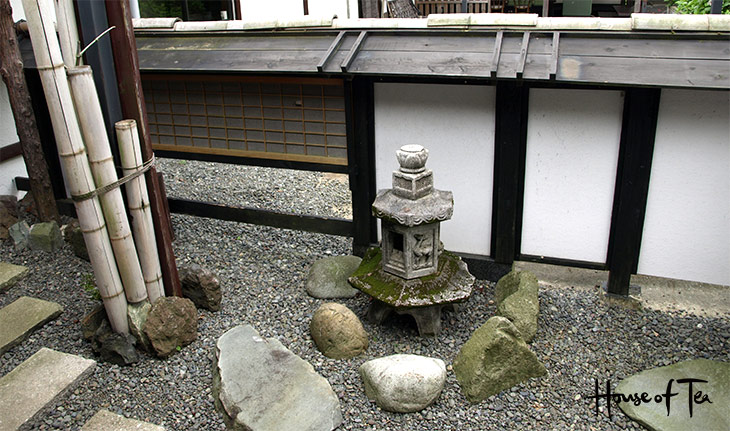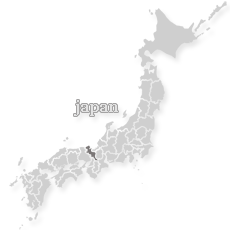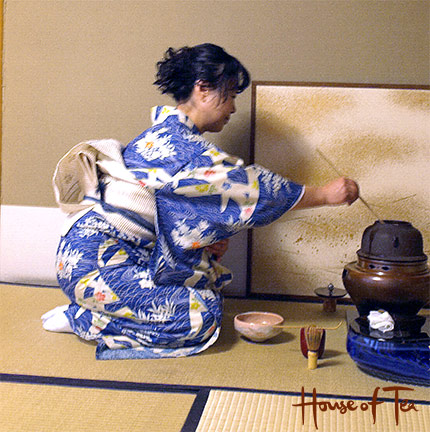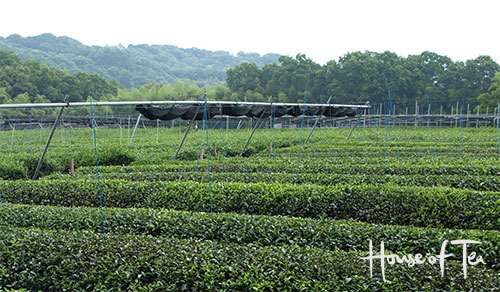Japanese tea

HISTORY OF JAPANESE TEA
The first tea is said to have come to Japan in the 800’s. Saicho, "Dengyo Daishi" , a Buddhist monk traveled in the year 804 to China for studies of what came to be Tendai Buddhism, and also for the blessing of his temple at Mt. Hiei that was to become a center for Tendai teachings.
Tendai joined Chinese Tiantai Buddhism with various elements of Zen and other teachings, and became the most dominant form of Japanese Buddhism for a very long time.
When Saicho returned from his studies in 805 first tea seeds were brought to Japan from China. There are however reports that suggests that tea bushes grew in Japan, but the Japanese did not have the knowledge how make green tea.
TEA AND BUDDHISM
Tea has historically been closely associated with Buddhism, and there are legends about the origin of tea bushes that are said to come from Bodhidharmas eyelids when he cut off his eyelids in a nine year long meditation. Bodhidharma is a legendary monk and has been said to be the founder of Zen Buddhism. Bodhidharma has been associated with tea, but also the origins of the martial art of Kung Fu. Kung Fu (Gong Fu) is a martial art for many, but it is also the name of the Chinese form of the tea ceremony as it is translated to skill achieved through practice.
The tea has existed in Japan from the 800’s, and was spread between monks and high-born right up to the 1200’s. The tea spread among royalty when the ruler Saga called for the cultivation of tea. In the 1200’s tea came back into Japan, this time by the Buddhist monk Eisai, who went to China to study Zen, a form of Buddhism. Eisai was the one who introduced Zen in Japan. Eisai gave these seeds to the monk Myoe Shonin, said to be the founder of the first tea plantations in Uji, Kyoto.
Eisai wrote in 1191 a book that describes how green tea has a positive effect on the five vital organs with the heart in focus. This claim has by studies in modern times shown to be true. Tea spread to the Samurai warriors and among monks. Tea at this time did not look like the tea we drink today. The tea was powdered, tea like Matcha tea was used.
It was not until the production of the tea increased the tea was spread to common people. In the 1600’s tea had spread to all classes, and the Japanese tea ceremony, Chado "The Way of Tea" or Chanoyu, was refined by Sen no Rikyu, who made the tea ceremony into what it is today. The Japanese are proud of their culture, and Japan is committed to maintaining its traditions.JAPANESE TEA REGIONS
Japans tea is not grown at high altitudes compared to the rest of Asia. The highest mountain in Japan is the sacred mountain Fuji. Contrary to what you might think, the best teas are not always from the Fuji Mountain region. Tea plantations closest Fuji are modern mechanized high-producing production plants to mass produce cheap Sencha teas.
SHIZUOKA

This is where you will find the largest production of tea in Japan. 20 000 ha of tea plantations are located here. More than 40% of the Japanese tea is produced here. Most of the production is Sencha tea. Much of the production is low grade machine-made and machine-picked, but it is also possible to find high quality teas here. Honyama, Kawane, Shida and Tenryu is known for quality tea, while Makinohara and Fuji Numazu is modern large-scale producers. Okabe, known for its Gyokuro production is located in Shida.
KYOTO

Kyoto is an incredibly beautiful city, famous for a variety of temples and beautiful buildings. The most famous area in Kyoto regarding to tea is Uji. This is where it all started with green tea for Japan, and it is here quality is to be found. Uji, Kyoto is one of the oldest cities in Japan. Uji is a region where tea has been grown in the same traditional way for a thousand year, and the name is also a seal of quality for tea from the region, "Ujicha" .
KAGOSHIMA
The second largest production area after Shizuoka. Teas have not been produced here for long, but many quality teas come from Kagoshima. Kagoshima has a cultivation area of 8500 hectares. It produces a great variety of Japanese teas. The town is located in southern Japan, located on the southern part of the island of Kyushu. In Kagoshima Fukamushi sencha is produced, a variant of sencha tea with a longer steaming process. Fukamushi sencha gets a sweeter taste from the process.
FUKUOKA
Fukuoka is a town located on the north side of the island of Kyushu. Yame in Fukuoka is famous for production of Gyokuro, and produces most Gyokuro in Japan. Yame produces 40% of Japans all Gyokuro.
JAPANESE TEAS
Although most Japanese teas look alike, there is a relatively large variation in taste. Japan produces mostly green tea, but even if green tea is the main production type other types of teas are starting to appear. China has a greater variety of teas, where they allow oxidation and hence produces white teas, yellow teas, green teas and oolong teas. In China size of tea leaves, elevation and where the tea is grown is an important factor. As teas in Japan usually are steamed, the taste of Japanese teas quite differ from Chinese teas.
What matters for all teas is the time of the year when the tea is harvested. First picking in Japan is done in the middle of April, depending on weather, and with the last harvest sometime in the fall. In Japan generally all teas get the same look after the manufacturing process. Shadowing of the tea plant is part of the production, of some teas. Gyokuro and Kabuse are shaded for a certain time before harvesting. This reduces the amount of flavonoids in tea and increases the amount of the amino acid Theanine. Theanine enhances sweet taste in the tea. Gyokuro contains the highest percentage of amino acid theanine of all teas. In Japan it is believed that theanine reduces stress and increase concentration. Gyokuro is the sweetest Japanese tea. Flavonoids and caffeine in tea is bitter.
SHINCHA
Is rarely seen outside of Japan. Known as "fresh tea." The first tea that comes in the spring. Often contain a higher degree of moisture in the leaves, and can not be stored for long. Not all tea from the first harvest is Shincha, part of the fresh tea is Sencha. Shincha comes out for sale immediately, while Sencha is added for storage by freezing.
SENCHA
Really means "roasted tea" , and the name suggests to its former production methods. Today the tea is steamed, as is customary in the manufacture of Japanese tea. The quality of Sencha tea varies widely, and is often associated in Sweden with a low quality drink that can be bought in most tea shops. Sencha can be of very high quality, and this mainly is early harvested Sencha. Sencha quality depends on the season, cultivation site and what is done with the tea leaves. Sencha is made mostly from Yabukita cultivar, but also other tea bushes are used such as Okumidori. First picking takes place in April to May.
KABUSE
A type of Sencha shaded 45% two weeks before harvest. This gives the tea a very sweet flavor and resembles of Gyokuro.
MATCHA TEA

Unlike regular tea where tea leaves are steeped in water, matcha tea consists of ground tea leaves. The tea leaves that are ground is of Gyokuro type, shaded tea. The tea is ground into a fine powder through a stone mill. It takes an hour to produce just under 40 grams of Matcha tea.
Two kind of beverages are made from matcha tea. Koicha and usucha. That translates to thick tea and thin tea. Only the highest quality of Matcha is recommended for making koicha. For koicha use less water. Matcha of low quality is bitter to the taste, and would not taste good in as a strong beverage. Tea powders of varying types have appeared on the market, ground Sencha or other kinds of tea. This is not genuine Matcha tea, this is tea powder.
GYOKURO
Manufactured only from first flush tea, and shaded 90% about 20 days before harvest. Shading enhances amino acids in the tea, and reduces polyphenol catechins. The tea will have a darker color and a sweet taste. Gyokuro is usually aging for a few months in the fridge before sale.
Gyokuro is produced from Ten Cha, for cultivation a different cultivar that Yabukita is often used. This reduces photosynthesis, reduces the levels of flavonoids and raises the amount of amino acids. This gives the tea a sweet taste.
Three regions are known for their Gyokuro production, Uji in Kyoto, Yame in Fukuoka and Okabe in Shizuoka. Gyokuro is often made from Gokoh, Asahi, Komakage or Ujimirodi shrubs. This is what is called a cultivar. This is not the same cultivar as Sencha, where Yabukita is very common.
Gyokuro is traditionally prepared in a different way compared to other Japanese tea, we have described the method for this preparation on the link below:

BANCHA
The meaning of the word is "regular tea", the tea is low grade Sencha harvested later in the summer and fall. Bancha often contain larger leaves, and larger stems. Bancha is less aromatic and has more astringency taste.
KUKICHA
Contains a blend of leaves with stems. Have a light taste, a mild sweetness.
HOJICHA
Produced by roasting Bancha or Kukicha. It has a roasted note in taste. The tea is not bitter, but do not look like a green tea. The color reminds of a black tea.
GENMAICHA
A blend of bancha with roasted brown rice. (genmai) The rice gives a nutty flavor.
KOCHA
Japanese black tea. Japan was a producer of black tea until 1955. After 1955 the competition was too hard and production of Japanese black tea was stopped. Today only a small production remains to meet domestic market, black tea is not exported in large scale.
PRODUCTION OF JAPANESE TEA
Although much of the tea today is manufactured by machines, there still are some teas produced partly by hand using traditional methods.
Here is how the Japanese tea is produced:
The first process of manufacturing is picking of tea leaves. The tea leaves are picked either in spring or in summer well into the autumn.
The tea leaves are shaked a number of times and the tea passes into the steamer. The leaves are steamed, and maintains hereby its green color, the oxidation of the tea is stopped by the heating process.
The steaming time depends on the type of tea and the steaming process has to do with the teas quality. It is precision work, where time must be adapted to the leaf quality
Virtually all Japanese tea is green tea, except for a very small production of other teas.
The tea leaves will go into the chiller, which cools down the steamed leaves to room temperature, and removes surface water.
The leaves are dried with hot air, while they are rolled under high pressure for an even moisture content. The liquid disappears and the remaining moisture is distributed evenly in the tea leaves.
Again, the leaves are dried with hot air and then dried by heating. The leaves are dried until they become round
This is the last roller. The tea leaves are dried by heat and pressure is applied for the leaves to get the last typical form. Nearly all Japanese tea looks like tiny green needles.
The tea leaves are dried to ultimately end up in an oven where the liquid level in the tea is reduced from 13% to 5%.
Optionally the tea is going further to a grading machine which remove the stalks, and finally the tea is packed.
HAND PRODUCED TEA
Multiple methods existed for making Japanese tea by hand, but one of the methods became dominant. Temomi is the method for producing hand-made tea. After the tea is steamed, the tea is laid out on a large table on which a man skillfully rolls and rub the tea. Temomi takes approximately 4 hours to perform.
KYUSU - THE JAPANESE TEAPOT
The most famous Japanese city associated with teapots is Tokoname. In Tokoname teapots has been made in nearly a thousand years. Tokoname has become a big brand primarily in Japan, but also outside of Japan. Tokoname teapots are as big in Japan, as Yixing teapots are in China. Red clay was found in the early 1800’s and came to be a signum for Tokoname caramics. The clay is rich in iron oxide, and is fired on high temperatures. However today there is no natural clay left in Tokoname and the clay is blended.
Famous are also the Banko teapots from Mie prefecture, made of Japanese purple clay. A natural clay that withstand very high temperatures when fired.
Kyusu is the typical Japanese teapot is with a handle on the side. The teapot usually has a strainer inside that filters tea leaves. The teapot is usually small in size, as this is the most practical way to make tea and customary throughout Asia.
